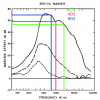ctrl
Major Contributor
A plausible explanation - cool!That seems very strange to me, and anomalous with respect to other research.
I wonder if there wasn't a confounding factor in this particular test. They do say that:...
I suspect that distortion in the test equipment at 70dB SL, which apparently was its maximum output at 150Hz, is the most plausible explanation for the anomalous result here.
This would also explain why at 50dB SL it "only" shows the expected "moving together of the listening thresholds" for HD2-HD5.
It would be instructive to have more sources on the subject of "masking in the low bass range".
In the study one can see the effect of "moving together of the listening thresholds" with the 350Hz masker.

A broadening of the masking range towards low frequencies is already evident in Zwicker's studies.

Would be really interesting to see how it behaves at 100Hz.